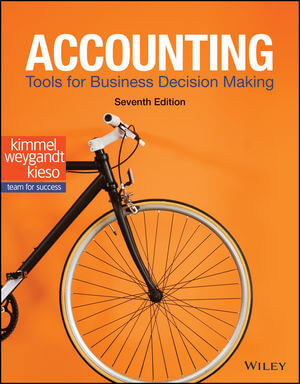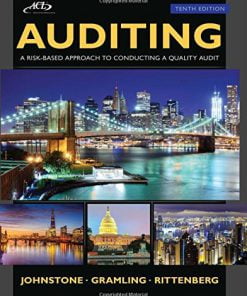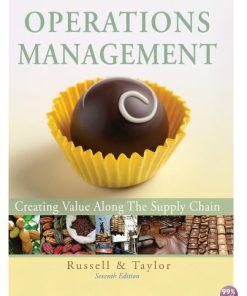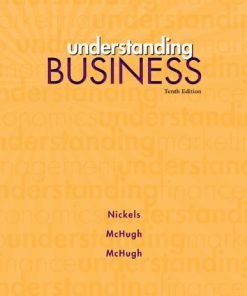Solution Manual for Accounting Tools for Business Decision Making 7th by Kimmel
$35.00 Original price was: $35.00.$26.50Current price is: $26.50.
Solution Manual for Accounting Tools for Business Decision Making 7th by Kimmel
Instant download Solution Manual for Accounting Tools for Business Decision Making 7th by Kimmel pdf docx epub after payment.

Product details:
- ISBN-10 : 1119494788
- ISBN-13 : 978-1119494782
- Author: Paul D. Kimmel; Jerry J. Weygandt; Donald E. Kieso
Accounting: Tools for Business Decision Making, 7th Edition is a two-semester financial and managerial accounting course designed to show students the importance of accounting in their everyday lives. Emphasizing decision-making, this new edition features relevant topics such as data analytics as well as the time-tested features that have proven to be of most help to students.
Table of contents:
1 Introduction to Financial Statements 1-1
Knowing the Numbers: Columbia Sportswear Company 1-1
Business Organization and Accounting Information Uses 1-2
The Three Types of Business Activity 1-7
The Four Financial Statements 1-9
A Look at IFRS 1-42
2 A Further Look at Financial Statements 2-1
Just Fooling Around?: The Motley Fool 2-2
The Classified Balance Sheet 2-3
Analyzing the Financial Statements Using Ratios 2-8
Financial Reporting Concepts 2-15
A Look at IFRS 2-45
3 The Accounting Information System 3-1
Accidents Happen: MF Global Holdings Ltd 3-1
Using the Accounting Equation to Analyze Transactions 3-3
Accounts, Debits, and Credits 3-11
Using a Journal 3-17
The Ledger and Posting 3-20
The Trial Balance 3-30
A Look at IFRS 3-61
4 Accrual Accounting Concepts 4-1
Keeping Track of Groupons: Groupon 4-1
Accrual-Basis Accounting and Adjusting Entries 4-2
Adjusting Entries for Deferrals 4-7
Adjusting Entries for Accruals 4-14
The Adjusted Trial Balance and Closing Entries 4-21
Appendix 4A: Using a Worksheet 4-33
A Look at IFRS 4-65
5 Merchandising Operations and the Multiple-Step Income Statement 5-1
Buy Now, Vote Later: REI 5-1
Merchandising Operations and Inventory Systems 5-3
Recording Purchases under a Perpetual System 5-6
Recording Sales under a Perpetual System 5-11
Multiple-Step and Comprehensive Income Statements 5-15
Cost of Goods Sold Under a Periodic System 5-21
Gross Profit Rate and Profit Margin 5-22
Appendix 5A: Periodic Inventory System 5-26
Appendix 5B: Adjusting Entries for Credit Sales with Returns and Allowances 5-29
A Look at IFRS 5-54
6 Reporting and Analyzing Inventory 6-1
“Where Is That Spare Bulldozer Blade?”: Caterpillar 6-1
Classifying and Determining Inventory 6-2
Inventory Methods and Financial Effects 6-6
Inventory Presentation and Analysis 6-15
Appendix 6A: Inventory Cost Flow Methods in Perpetual Inventory Systems 6-21
Appendix 6B: Effects of Inventory Errors 6-23
7 Fraud, Internal Control, and Cash 7-1
Minding the Money in Madison: Barriques 7-1
Fraud and Internal Control 7-3
Cash Controls 7-12
Control Features of a Bank Account 7-17
Reporting Cash and Cash Management 7-24
Appendix 7A: Operation of a Petty Cash Fund 7-30
A Look at IFRS 7-56
8 Reporting and Analyzing Receivables 8-1
What’s cooking? Nike 8-1
Recognition of Accounts Receivable 8-3
Valuation and Disposition of Accounts Receivable 8-5
Notes Receivable 8-14
Receivables Presentation and Management 8-18
A Look at IFRS 8-47
9 Reporting and Analyzing Long-Lived Assets 9-1
A Tale of Two Airlines: American Airlines 9-1
Plant Asset Expenditures 9-3
Depreciation Methods 9-9
Plant Asset Disposals 9-15
Intangible Assets 9-18
Statement Presentation and Analysis 9-21
Appendix 9A: Other Depreciation Methods 9-27
A Look at IFRS 9-54
10 Reporting and Analyzing Liabilities 10-1
And Then There Were Two: Maxwell Car Company 10-1
Accounting for Current Liabilities 10-3
Major Characteristics of Bonds 10-8
Accounting for Bond Transactions 10-12
Presentation and Analysis 10-18
Appendix 10A: Straight-Line Amortization 10-24
Appendix 10B: Effective-Interest Amortization 10-27
Appendix 10C: Accounting for Long-Term Notes Payable 10-30
A Look at IFRS 10-58
11 Reporting and Analyzing Stockholders’ Equity 11-1
Oh Well, I Guess I’ll Get Rich: Facebook 11-1
Corporate Form of Organization 11-3
Accounting for Common, Preferred, and Treasury Stock 11-11
Cash Dividends, Stock Dividends, and Stock Splits 11-15
Presentation and Analysis 11-22
Appendix 11A: Entries for Stock Dividends 11-30
A Look at IFRS 11-54
12 Statement of Cash Flows 12-1
Got Cash?: Microsoft 12-1
Usefulness and Format of the Statement of Cash Flows 12-3
Preparing the Statement of Cash Flows—Indirect Method 12-6
Analyzing the Statement of Cash Flows 12-17
Appendix 12A: Statement of Cash Flows—Direct Method 12-22
Appendix 12B: Worksheet for the Indirect Method 12-29
Appendix 12C: Statement of Cash Flows—T-Account Approach 12-34
A Look at IFRS 12-61
13 Financial Analysis: The Big Picture 13-1
It Pays to Be Patient: Warren Buffett 13-2
Sustainable Income and Quality of Earnings 13-3
Horizontal Analysis and Vertical Analysis 13-9
Ratio Analysis 13-14
A Look at IFRS 13-54
14 Managerial Accounting 14-1
Just Add Water … and Paddle: Current Designs 14-1
Managerial Accounting Basics 14-3
Managerial Cost Concepts 14-7
Manufacturing Costs in Financial Statements 14-10
Managerial Accounting Today 14-14
15 Job Order Costing 15-1
Profiting from the Silver Screen: Disney 15-1
Cost Accounting Systems 15-3
Assigning Manufacturing Costs 15-7
Predetermined Overhead Rates 15-12
Entries for Jobs Completed and Sold 15-15
Applied Manufacturing Overhead 15-20
16 Process Costing 16-1
The Little Guy Who Could: Jones Soda 16-1
Overview of Process Cost Systems 16-3
Process Cost Flow and Assigning Costs 16-6
Equivalent Units 16-9
The Production Cost Report 16-12
Appendix 16A: FIFO Method for Equivalent Units 16-19
17 Activity-Based Costing 17-1
Precor Is on Your SiÞ: Precor 17-1
Traditional vs. Activity-Based Costing 17-3
ABC and Manufacturers 17-7
ABC Benefits and Limitations 17-12
ABC and Service Industries 17-17
Appendix 17A: Just-in-Time Processing 17-22
18 Cost-Volume-Profit 18-1
Don’t Worry—Just Get Big: Amazon.com 18-1
Cost Behavior Analysis 18-2
Mixed Costs Analysis 18-7
Cost-Volume-Profit Analysis 18-10
Break-Even Analysis 18-14
Target Net Income and Margin of Safety 18-18
Appendix 18A: Regression Analysis 18-22
19 Cost-Volume-Profit Analysis: Additional Issues 19-1
Not Even a Flood Could Stop It: Whole Foods Market 19-1
Basic CVP Concepts 19-3
Sales Mix and Break-Even Sales 19-8
Sales Mix with Limited Resources 19-12
Operating Leverage and Profitability 19-14
Appendix 19A: Absorption Costing vs. Variable Costing 19-19
20 Incremental Analysis 20-1
Keeping It Clean: Method Products 20-1
Decision-Making and Incremental Analysis 20-3
Special Orders 20-6
Make or Buy 20-8
Sell or Process Further 20-10
Repair, Retain, or Replace Equipment 20-14
Eliminate Unprofitable Segment or Product 20-15
21 Pricing 21-1
They’ve Got Your Size—and Color: Zappos.com 21-1
Target Costing 21-3
Cost-Plus and Variable-Cost Pricing 21-5
Time-and-Material Pricing 21-10
Transfer Prices 21-13
Appendix 21A: Absorption-Cost and Variable-Cost Pricing 21-21
Appendix 21B: Transfers between Divisions in Different Countries 21-24
22 Budgetary Planning 22-1
What’s in Your Cupcake?: Baby Cakes NYC 22-1
Effective Budgeting and the Master Budget 22-3
Sales, Production, and Direct Materials Budgets 22-8
Direct Labor, Manufacturing Overhead, and S&A Expense Budgets 22-13
Cash Budget and Budgeted Balance Sheet 22-17
Budgeting in Nonmanufacturing Companies 22-22
23 Budgetary Control and Responsibility Accounting 23-1
Pumpkin Madeleines and a Movie: Tribeca Grand 23-1
Budgetary Control and Static Budget Reports 23-3
Flexible Budget Reports 23-6
Responsibility Accounting and Responsibility Centers 23-13
Investment Centers 23-22
Appendix 23A: ROI vs. Residual Income 23-28
24 Standard Costs and Balanced Scorecard 24-1
80,000 Different Caffeinated Combinations: Starbucks 24-2
Overview of Standard Costs 24-3
Direct Materials Variances 24-7
Direct Labor and Manufacturing Overhead Variances 24-11
Variance Reports and Balanced Scorecards 24-16
Appendix 24A: Standard Cost Accounting System 24-21
Appendix 24B: Overhead Controllable and Volume Variances 24-24
25 Planning for Capital Investments 25-1
Floating Hotels: Holland America Line 25-2
Capital Budgeting and Cash Payback 25-3
Net Present Value Method 25-6
Capital Budgeting Challenges and Refinements 25-11
Internal Rate of Return 25-16
Annual Rate of Return 25-18
APPENDIX A Specimen Financial Statements: Apple Inc. A-1
APPENDIX B Specimen Financial Statements: Columbia Sportswear Company B-1
APPENDIX C Specimen Financial Statements: VF Corporation C-1
APPENDIX D Specimen Financial Statements: Amazon.com, Inc. D-1
APPENDIX E Specimen Financial Statements: Wal-Mart Stores, Inc. E-1
APPENDIX F Specimen Financial Statements: Louis Vuitton F-1
APPENDIX G Time Value of Money G-1
Interest and Future Values G-1
Nature of Interest G-1
Future Value of a Single Amount G-3
Future Value of an Annuity G-5
Present Values G-7
Present Value Variables G-7
Present Value of a Single Amount G-7
Present Value of an Annuity G-9
Time Periods and Discounting G-11
Present Value of a Long-Term Note or Bond G-11
Capital Budgeting Situations G-14
Using Financial Calculators G-15
Present Value of a Single Sum G-16
Present Value of an Annuity G-17
Future Value of a Single Sum G-17
Future Value of an Annuity G-17
Internal Rate of Return G-18
Useful Applications of the Financial Calculator G-18
APPENDIX H Reporting and Analyzing Investments H-1
Accounting for Debt Investments H-1
Why Corporations Invest H-1
Accounting for Debt Investments H-3
Accounting for Stock Investments H-4
Holdings of Less Than 20% H-4
Holdings Between 20% and 50% H-5
Holdings of More Than 50% H-6
Reporting Investments in Financial Statements H-7
Debt Securities H-7
Equity Securities H-10
Balance Sheet Presentation H-11
Presentation of Realized and Unrealized Gain or Loss H-12
APPENDIX I Payroll Accounting I-1
Recording the Payroll I-1
Determining the Payroll I-2
Recording the Payroll I-5
Employer Payroll Taxes I-8
FICA Taxes I-8
Federal Unemployment Taxes I-8
State Unemployment Taxes I-8
Recording Employer Payroll Taxes I-9
Filing and Remitting Payroll Taxes I-9
Internal Control for Payroll I-10
APPENDIX J Subsidiary Ledgers and Special Journals J-1
Subsidiary Ledgers J-1
Subsidiary Ledger Example J-2
Advantages of Subsidiary Ledgers J-3
Special Journals J-4
Sales Journal J-4
Cash Receipts Journal J-7
Purchases Journal J-11
Cash Payments Journal J-13
Effects of Special Journals on the General Journal J-16
Cybersecurity: A Final Comment J-17
APPENDIX K Accounting for Partnerships K-1
Forming a Partnership K-1
Characteristics of Partnerships K-1
Organizations with Partnerships Characteristics K-2
Advantages and Disadvantages of Partnerships K-3
The Partnership Agreement K-4
Accounting for a Partnership Formation K-5
Accounting for Partnership Net Income or Net Loss K-6
Dividing Net Income or Net Loss K-6
Partnership Financial Statements K-9
Accounting for Partnership Liquidation K-10
No Capital Deficiency K-11
Capital Deficiency K-12
Admission and Withdrawal of Partners K-14
Admission of a Partner K-14
Withdrawal of a Partner K-18
APPENDIX L Accounting for Sole Proprietorships L-1
Corporation versus Sole Proprietorship Equity Accounts L-1
Accounts that Change Owner’s Equity L-2
Owner’s Equity in a Sole Proprietorship L-2
Recording Transactions of a Proprietorship L-3
Retained Earnings Statement versus Owner’s Equity Statement L-3
Closing the Books for a Sole Proprietorship L-4
Preparing a Post-Closing Trail Balance for a Proprietorship L-7
Company Index I-1
Subject Index I-3
People also search:
Accounting Tools for Business Decision Making 7th
Accounting Tools for Business Decision Making 7th pdf
Accounting Tools for Business Decision Making
accounting tools for business decision making answers
accounting tools for business decision making answer key
Related products
Solution Manual
Solution Manual for Introduction to Robotics Mechanics and Control 3rd Edition by Craig
Solution Manual
Auditing A Risk Based-Approach to Conducting a Quality Audit Johnstone 10th Edition Solutions Manual
Solution Manual
Solution Manual
Management Information Systems Managing the Digital Firm Laudon 14th Edition Solutions Manual
Solution Manual
Understanding Business Nickels 10th Edition Solutions Manual
Solution Manual
Solution Manual for Absolute C++, 5/E 5th Edition Walter Savitch











